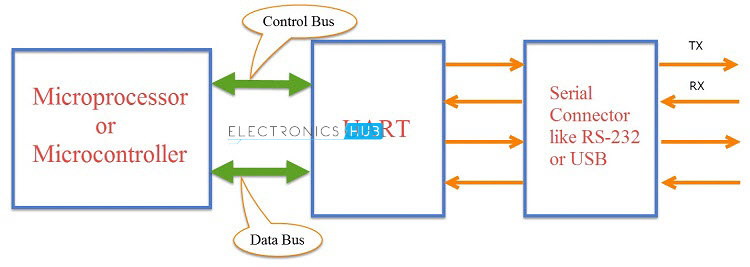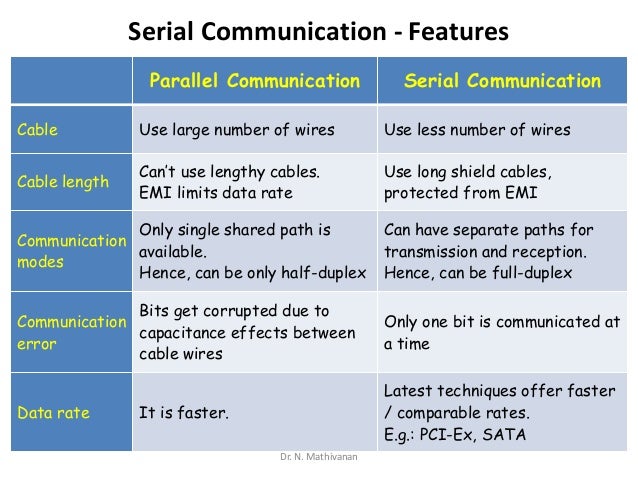Advantages Of Serial Communication Over Parallel Communication

The Question SuperUser reader Modest is curious about the data transfer rates of parallel and serial connections: Intuitively, you would think that parallel data transmission should be faster than serial data transmission; in parallel you are transferring many bits at the same time, whereas in serial you are doing one bit at a time. Autocad lisp steel sections sizes of diamonds for sale. So what makes SATA interfaces faster than PATA, PCI-e devices faster than PCI, and serial ports faster than parallel?
Data can be transmitted between a sender and a receiver in two main ways: serial and parallel. Serial communication is the method of transferring one bit at a time through a medium. Parallel communication is the method of transferring blocks, eg: BYTEs, of data at the same time. As you can appreciate parallel communication is faster than serial. The advantages and disadvantages of serial links in communication system design. 5) Differential serial links can drive longer distance than parallel buses and are less susceptible to noise. 6) Circuit board routing is simpler, as only two serial lines need to be routed, replacing a wide bus and the associated clock.
While it’s easy to fall into the reasoning that SATA is newer than PATA, there must be a more concrete mechanism at work than just age. The Answer SuperUser contributor Mpy offers some insight into the nature of the transmission types: You cannot formulate it this way.

Serial transmission is slower than parallel transmission given the same signal frequency. With a parallel transmission you can transfer one word per cycle (e.g. 1 byte = 8 bits) but with a serial transmission only a fraction of it (e.g. The reason modern devices use serial transmission is the following: • You cannot increase the signal frequency for a parallel transmission without limit, because, by design, all signals from the transmitter need to arrive at the receiver at the same time.
This cannot be guaranteed for high frequencies, as you cannot guarantee that the signal transit time is equal for all signal lines (think of different paths on the mainboard). The higher the frequency, the more tiny differences matter.
 Safenet Inc Usb Key may sometimes be at fault for other drivers ceasing to function These are the driver scans of 2 of our recent wiki members* *Scans were performed on computers suffering from Safenet Inc Usb Key disfunctions. Here is a step by step manual guide for SafeNet Inc. USB Key software installation process on Windows 7 / Vista / XP. 1 Download FLEXId_Dongle_Driver_Installer.exe file for Windows 7 / Vista / XP, save and unpack it if needed. Home » SafeNet Inc. USB Key Use the links on this page to download the latest version of SafeNet Inc. USB Key drivers. All drivers available for download have been scanned by antivirus program. Drivers Installer for SafeNet Inc. If you don’t want to waste time on hunting after the needed driver for your PC, feel free to use a dedicated self-acting installer. It will select only qualified and updated drivers for all hardware parts all alone. To download SCI Drivers Installer, follow this link. DriversDownloader.com have all drivers for Windows 8, 7, Vista and XP. And for Windows 10, you can get it from here: Windows 10 drivers download.From this website, you can find find almost drivers for the Dell, Acer, Lenovo, HP, Sony, Toshiba, AMD, NVIDIA, etc manufacturers.
Safenet Inc Usb Key may sometimes be at fault for other drivers ceasing to function These are the driver scans of 2 of our recent wiki members* *Scans were performed on computers suffering from Safenet Inc Usb Key disfunctions. Here is a step by step manual guide for SafeNet Inc. USB Key software installation process on Windows 7 / Vista / XP. 1 Download FLEXId_Dongle_Driver_Installer.exe file for Windows 7 / Vista / XP, save and unpack it if needed. Home » SafeNet Inc. USB Key Use the links on this page to download the latest version of SafeNet Inc. USB Key drivers. All drivers available for download have been scanned by antivirus program. Drivers Installer for SafeNet Inc. If you don’t want to waste time on hunting after the needed driver for your PC, feel free to use a dedicated self-acting installer. It will select only qualified and updated drivers for all hardware parts all alone. To download SCI Drivers Installer, follow this link. DriversDownloader.com have all drivers for Windows 8, 7, Vista and XP. And for Windows 10, you can get it from here: Windows 10 drivers download.From this website, you can find find almost drivers for the Dell, Acer, Lenovo, HP, Sony, Toshiba, AMD, NVIDIA, etc manufacturers.
Hence the receiver has to wait until all signal lines are settled — obviously, waiting lowers the transfer rate. • Another good point (from ) is that one needs to consider crosstalk with parallel signal lines. The higher the frequency, the more pronounced crosstalk gets and with it the higher the probability of a corrupted word and the need to retransmit it. [1] So, even if you transfer less data per cycle with a serial transmission, you can go to much higher frequencies which results in a higher net transfer rate.
[1] This also explains why (Parallel ATA with increased transfer speed) had twice as many wires as pins. Every second wire was grounded to reduce crosstalk. Scott Chamberlain echoes Myp’s answer and expands upon the economics of design: The problem is synchronization.
When you send in parallel you must measure all of the lines at the exact same moment, as you go faster the size of the window for that moment gets smaller and smaller, eventually it can get so small that some of the wires may still be stabilizing while others are finished before you ran out of time. By sending in serial you no longer need to worry about all of the lines stabilizing, just one line.
And it is more cost efficient to make one line stabilize 10 times faster than to add 10 lines at the same speed. Some things like PCI Express do the best of both worlds, they do a parallel set of serial connections (the 16x port on your motherboard has 16 serial connections). By doing that each line does not need to be in perfect sync with the other lines, just as long as the controller at the other end can reorder the “packets” of data as they come in using the correct order. The does a very good explination in depth on how PCI Express in serial can be faster than PCI or PCI-X in parallel.